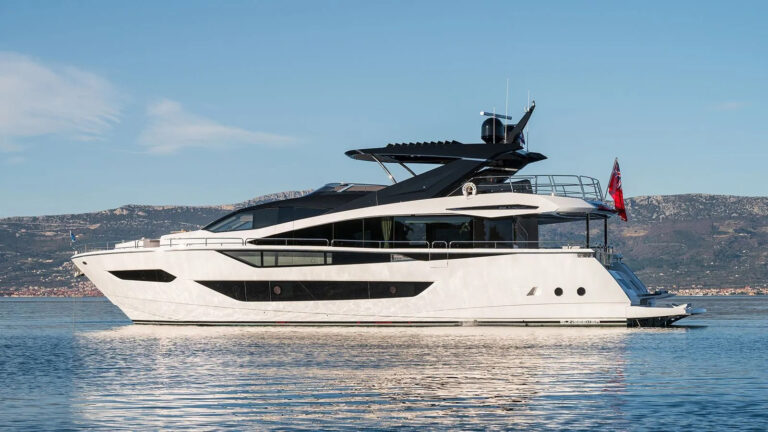You just pumped fuel into your yacht’s tank, but how do you know what’s really in it? Already, for instance, in most areas of the country the gas at the fuel dock will contain at least 10 percent ethyl alcohol, in the form of ethanol likely produced from corn. And if the agricultural equipment and farm lobbies have their way, that may be the case everywhere.
If your yacht engines run on diesel fuel, on the other hand, you may be filling up with diesel fuel that contains oil derived from plants, which in the U.S. usually means soybeans. But you won’t know how much. That diesel fuel may contain only a few percent of what is commonly called “bio diesel” or it might be B-20, which is 20 percent vegetable-derived oil.
Of even greater concern is the fact that the agricultural equipment and farm lobby is also aggressively promoting the addition of ethanol to diesel fuel, creating something called “E-diesel.” This is a fuel that would lack the safety advantages of today’s no-alcohol diesel fuels.
Regardless of the type of fuel you use, you need to know what fuels your engine will tolerate. That means going on what the engine’s manufacturer has to say, and not the opinion of those who are aggressively promoting the production and use of ethanol and soy oils.
E-10, 90 percent gasoline, 10 percent ethyl alcohol, uses the same alcohol we enjoy drinking, but with a bit of poison added. The alcohol is beneficial in many (especially cold) climates. It oxygenates the fuel, increases its octane number, enhances the combustion process in cold weather and reduces tailpipe emissions. (This is nothing new here, as it was doing the same thing in the 1920s and ’30s; see Sidebar.) E-10 basically does what MTBE did before it was widely removed from use because of its ability to infiltrate the water table and make drinking water taste terrible. Most marine engines can burn the E-10 with little difficulty, provided the boat does not have fiberglass fuel tanks. (E-10 fuel may dissolve a fiberglass fuel tank and the liberated material can ruin the engine and your day).
Adding ethanol to gasoline can even be helpful, raising the octane rating of the fuel by about 2 points. A modern, computer-controlled engine will automatically modify its fuel-to-air ratio to take advantage of the change in octane. The mixture setting of manually controlled engines, however, may have to be adjusted to make them run smoothly. Fuel consumption will likely increase by about 3 percent, reducing your boat’s range by the same amount since the E-10 mixture contains less energy per pound.
E-10 fuel causes few problems in cars and trucks. But the fuel system in a yacht, and the way fuel is used, is different. In today’s cars, for instance, the fuel system is totally closed; there is no open vent to the atmosphere, and air can enter the fuel tank only as fuel is withdrawn. In a boat, the tank vent is always open. Air flows out of the fuel tank as the temperature increases and flows back in when the temperature drops, causing an accumulation of water in the fuel.
Unlike cars, boats are often unused for days, weeks or months, during which a substantial amount of water can accumulate in the fuel. And that’s a problem for E-10 fuel, because it is not as stable in your fuel tank as conventional gasoline. Only about 0.3 percent water (just over 2 teaspoons per gallon) is enough to trigger the phase separation of the fuel, with about 75 percent of the ethanol separating from the mixture. The portion that contains the alcohol and water will settle to the bottom of the tank and if it reaches the fuel pick-up the engine will quit. Once the mixture has separated no amount of stirring will restore it to usable form.
If your boat must be fueled with E-10 be sure to add a stabilizing chemical to the fuel each time you add fuel. Check the fill pipe cap gasket to ensure that spray or rainwater can’t flow into the tank. Do not try to seal the tank vent, as the engine won’t run properly (or at all) if you do; sealing the vent when the boat is stored might cause a rupture of the tank. Periodically checking for the presence of phase-separated fuel at the bottom of the tank is an excellent precaution and can be done using a dip-stick coated with one of the readily available water detecting/color change pastes.
Your New Diesel
The diesel fuel you buy today is very likely to be different from the fuel you purchased last year. It is ULSD, Ultra Low Sulfur Diesel, with a sulfur content of not more than 15 parts per million-quite a difference considering that the former low-sulfur diesel could contain up to 500 ppm. Although ULSD is not mandatory for locomotive, off-road or marine uses, your fuel dock will likely be dispensing it since supplying LSD (ignore the unfortunate acronym) to a marina will not be economical for most fuel depots.
Although the process used to remove the sulfur from the fuel reduces its lubricity, additives have been blended into the fuel to protect the precisely machined surfaces of the diesel injection system. And there is an upside, as the availability of ULSD makes it possible for automobile makers to offer advanced diesel engine vehicles in the U.S. market. You won’t likely notice the difference in the way your yacht’s engines operate, other than perhaps the 1 percent increase in fuel consumption that results from its slightly lower energy content. The fuel will be compatible with older engines and well liked by the latest electronically controlled engines.
Meanwhile, depending on where you yacht, it might be veggie time at the fuel dock thanks to bio-diesel, an option that has received a great deal of positive publicity. As with E-10 (and to an even greater extent E-85, which is 85 percent alcohol, 15 percent gasoline) the use of “renewable” energy is on the face of it a great idea. Bio-diesel is especially attractive for those who like the whimsical idea of buying their fuel from the closest fast-food restaurant in the form of used cooking oil.
However, the Department of Energy bio-diesel use guideline strongly recommends against the use of raw or refined vegetable oil or greases that have not been specifically processed for use as a component of diesel fuel, and engine manufacturers flatly prohibit such stuff for engines under warranty.
So much for dumping your French fry oil directly into your tank.
A number of marine diesel engine manufacturers advise that the maximum vegetable oil content of fuel used in their engines not exceed 5 percent. Some, including MAN, one of the most respected marine diesel engine manufacturers, require that lube oil, oil filter and fuel filter change interval be halved if 5 percent bio diesel is used. The energy content of bio-diesel is lower than that of straight petroleum diesel. B-20, the mixture often used in various tests in school buses, produces as much as 3 percent less energy than conventional diesel; energy deficits for lower vegetable oil concentrations are proportional.
Another diesel fuel, E-Diesel, is a blend of diesel with between 7.7 and 15 percent ethanol. It is being promoted by the usual suspects. As presently constituted, this fuel would have very serious consequences if used to fuel a diesel yacht. The addition of ethanol to diesel fuel is reported to reduce emissions of particulates, nitrogen oxides and carbon monoxide (there is very little carbon monoxide in diesel exhaust).
However, from the flammability standpoint E-Diesel resembles gasoline and would be a major hazard if used in vessels whose fuel tanks, fuel distribution piping, filters and engine fuel systems were not specifically designed to deal with the hazard imposed by the fuel. (The fuel fill for a tank intended for E-Diesel would have to be equipped with a flame arrestor). At present the testing of E-Diesel is being done primarily in farm equipment and trucks, applications where the stringent safety requirements that necessarily apply to marine use of fuels such as gasoline do not apply. At this time most of the test reports on E-Diesel are from parties with a vested interest in promoting the fuel. Cummins and MAN warn against its use b ecause of concerns over fire safety and possible detrimental effects on engine components.
New Fuel Rules
If using gasoline, keep tank full, use additives, check for water at least once a season, avoid E-10 if you can.
If using diesel, don’t use bio or vegetable diesel unless engine manufacturer has specifically blessed the fuel you are considering using. If offered E-Diesel, cast off and leave at flank speed.
Additivies In Gasoline
Oil companies have advertised the benefits of what they are adding to their fuels since the 1920s. That’s when ethanol was being added to gasoline with the active blessing of both Henry Ford and Charles Kettering, head of research at General Motors. Although effective in increasing gasoline’s octane number, ethanol lost out to tetraethyl lead (TEL) in the early 1930s. But then the toxicity of TEL led to it being phased out as a motor fuel additive in the U.S. in 1986. Texaco boasted of something called TCP (Tricresyl phosphate), while Chevron boasted of the advantages of Techron. MTBE, methyl-butyl ether, does boost octane while reducing emissions of carbon monoxide and ozone, and so was popular-until its ability to contaminate ground water with a malodor that was noticeable in concentrations as low as 15 parts per million became known. The need for something other than MTBE was in part responsible for the switch to ethanol, a return to the past.









